A bit of a cheat actually this time. First a couple more early photos from mid-1990 I would guess:
In September 1996, three months after the car finally took to the road, I wrote a fairly brief history of the project fror the English Lancia Club magazine. I propose to repeat it here since it does give an overall idea of the project; a few things have changed since then, but in those days I probably had a better memory!
Here is the first part of the article:
At the recent Castle Combe track day, my car finally made its appearance after what seems to have been an interminable gestation period (seven years).
It is not and never will be, finished.
However, following an all too brief spell on the track due to a faulty condenser and a cracked cylinder block (which was due to my negligence!) many visitors expressed interest in the car. For me, an inveterate fiddler and modifier, this was very satisfying, as I am aware that specials are, to say the least, not nearly as much "the thing" as they were in Julian Jane's day.
Anyway, this piece is neither to be a cri-de-coeur nor a tedious account of every weld or piece of fabrication until the triumphant day when the car "passed its MoT with flying colours" - why do they always say that? (it did actually).
No, apart from a few disconnected jottings, I just wish to express my grateful thanks to the many kind friends who have helped and also to the numerous motor-manufacturers whose designers (unwittingly) contributed parts. These I list at the end.
Thanks to Gerald Batt and Harry's neighbours, the Deadmans, I was able to collect OMY 142E from Harry's premises after his death
· The car, for which Harry had paid £60, turned out to be composed roughly of 65% steel, 25% filler, the balance being mostly oily filth, holes, cobwebs etc.
· After about three months of weekends welding, I had a shell.
· Since the project was not done "aircraft-style" - i.e. drawings first (I can't draw) it developed organically. Examples of this include the purchase of various steel wheelarches, the three different mounting-places for the oil-cooler, two mountings for the injection, three radiators etc.
· Why injection? A number of people asked me this at 'Combe. Well first of all, I've always admired the Lucas mechanical system both for its success over twenty years of motor racing and for its ingenuity - just three moving parts in the metering unit and two of those running at clearances of .0001"! I was, of course, aware of the works efforts with the Kugelfischer system, but no-one's ever told me how much power was obtained. There are rumours that such a 1600 came to England but after fifteen years of Lancias I have yet to meet anyone who has seen a VAR 1016 Fulvia, let alone an Iniezione! Anyway, I was very fortunate to be offered a Lucas 6mm 4-cylinder unit with a Cosworth drive and 4 injectors at a price I could afford, so then I was committed.
· The idea was to reduce the overall length of the inlet tract, which is especially long and tortuous if the works manifold with 45s or 48s is used. I have plans to shorten the tract still further. The reason is that a shorter tract will improve top-end power and together with injection, provide much-improved throttle response - never the Fulvia's strong point. Additionally, injection provides superior atomisation of the intake charge - essential with long ports - and thereby additional mechanical "octanes" by virtue of a better burn.
At a recent rolling-road test, the engine delivered 110 b.h.p.(and climbing) at the wheels at 6700 r.p.m. Unburned hydrocarbons were very low - 95 p.p.m. proving the "burn" theory. Incidentally the power output is equivalent to about 145 b.h.p. at the flywheel. I am still using the original Cosworth F2 fuel cam which came with the injection which is hardly suitable, whilst the ignition timing is actually a guess - we didn't touch it during the test session - there wasn't time; neither has the cam timing been addressed.
· More work has to be done on the exhaust system. I have found that Fulvias respond very favourably to attention in this area. This may seem a platitude, but take a look at the dismal exhaust valve-throat area on a standard Fulvia head and I'm sure you'll agree. Another thing: why did Lancia use the 1300 manifold on the 1600? The fact that stainless steel was used is really an admission of failure - I've seen them red-hot! The fact that I have virtually to dismantle the entire front of my car to remove my fabricated 4-into-1 manifold is another admission altogether of course! There's really very little room; back to the (virtual) drawing-board, I suppose.
· As for the rest of the car, the approach has been to make it as solid as possible keeping weight to a feasible minimum; it is still too heavy. Following Peter Gerrish's suggestion in the Fulvia Journal, the sills have a central membrane. Seam welding serves to integrate the "A" post into the sill structure with further triangulation of the flitches forward and above, that. I have done away with the troublesome boxes by simply removing the rear portion of the sub-frame and mounting it where Nature (and Fessia) intended - in the original place; a lot of work, but weight is saved and rigidity gained. There are solid bushes (from Barry Waterhouse) and my ball-race front spring mounts beautifully executed by Doug Ellis.
· Next? Well, how about a mechanical fuel-pump (always the Lucas bugbear) dry sump, rose-jointed outer front anti-roll bar mounts, alloy brake-disc bells etc? It's nice to dream...
Actually, before Goodwood (next spring), I have to dismantle the car and rebuild the engine, hopefully with the magic head that Peter Ward has been threatening to do for me which he says will (with a proper fuel-cam etc) provide 175 b.h.p. with torque to match. I have to re-think the exhaust manifold, the heat from which causes great suffering to the steering idler box and I also have to polish out the runs in my paintwork. As I said, it will never be finished...
***************************
Next time, the rest of the article which gives some specifications and other details.



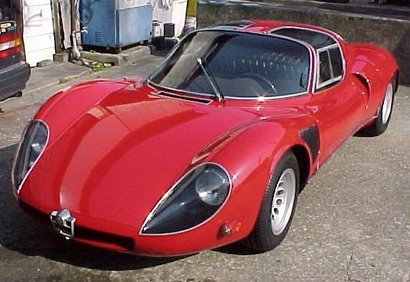
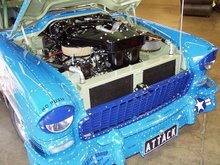
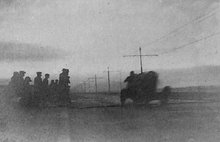

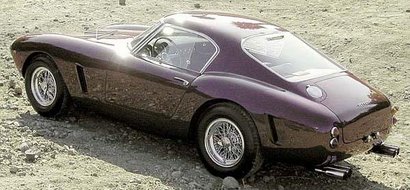
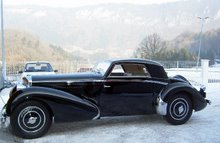
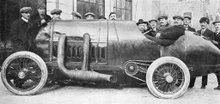


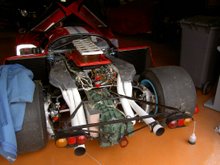

7 comments:
"infinate fidler and modifier" I would proudly wear a T-shirt saying that!
Do you mean by relocating the aft subframe mounts were Fessia inteded the Flavia and Fulvia 1C location? And why isn that more rigid? I would expect the wider the better. Never understood why lancia changed it for the Fulvia but left the Flavia alone.
If you think about the line longitudinally from the front mounts, through the upper middle ones to my mounts (in the original 1C position you will see that the beam strength is increased compared with the later version - no "bending moment" on the arms - because: no arms. I think it was changed for noise transmission reasons and/or crash deformation considerations but I have no information on this
If you are right about the noise or safety issues it would have been changed in the Flavia design as well. The subframe itself is undoubtedly stiffer in Flavia/Fulvia 1C set-up but I think because of the wide attachment to the body the body itself makes up for the weaker subframe. We will never know!
If you are right about the noise or safety issues it would have been changed in the Flavia design as well. The subframe itself is undoubtedly stiffer in Flavia/Fulvia 1C set-up but I think because of the wide attachment to the body the body itself makes up for the weaker subframe. We will never know!
Not necessarily: consider that the body was quite differebt, as was the engine
During work on the current project of putting a 2000 engine in a Fulvia I had to make two subframes into one. I took the flavia front and attached a Fulvia rear section to it. If I understand correctly I might as well have adapted the Fulvia body to take the Flavia subframe altogether! probably less work as well.
Yes, William: whilst I am not 100% certain, I suspect you might be right. I cannot remember quite why I didn't use the 2000 subframe!
Another point: Flavia subrames do not rust like Fulvia ones!
Post a Comment